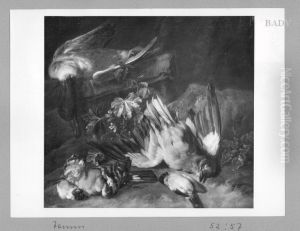Franz Werner Tamm Paintings
Franz Werner Tamm, also known as Dapper Franz or Franz Werner von Tamm, was a German painter who made a significant contribution to the Baroque period, particularly in the field of still life and animal painting. Born in Hamburg in 1658, Tamm came from a family of artists; his grandfather, father, and brother were all painters, which likely influenced his early exposure and interest in the arts.
Tamm moved to Italy as a young man and spent considerable time in Rome, which was a major center for artists during the 17th century. In Rome, he was deeply influenced by the works of Italian masters and he absorbed the Italianate style, which would later be reflected in his own pieces. After his stay in Rome, Tamm worked in Naples, where he was influenced by the works of the Spanish still-life painter, Juan de Espinosa and the Neapolitan Giuseppe Recco. Tamm's style was characterized by a combination of precise detail, rich coloration, and the dramatic lighting typical of Baroque art.
In 1685, Tamm was called to Vienna by Emperor Leopold I, where he became a court painter. His work was highly appreciated by the imperial court, and he enjoyed a successful career there. His paintings during this period often featured game pieces and hunting trophies, in accordance with the tastes of the aristocracy, as well as floral still lifes. Tamm's compositions were known for their elegance and the skill with which he rendered textures and surfaces, such as the softness of feathers and the sheen of metal or glass.
Franz Werner Tamm's work spread beyond Vienna, and he became known across Europe. He was one of the artists who helped disseminate the Baroque style across the continent, particularly in terms of still life painting. His influence extended to his students and followers, who continued his style and helped to further his legacy.
Tamm continued to work and receive commissions until his death in 1724. Today, his works can be found in various art collections and museums, where they are recognized for their contribution to the development of still life and animal painting in the Baroque period. His ability to blend the precision of Northern European painting with the warmth and drama of Italian Baroque made him a distinctive artist of his era.







